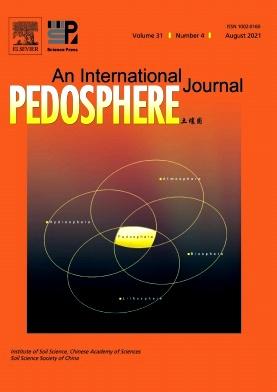在使用盐水的淤泥粘土中使用梧桐叶生物炭改善土壤湿润性
IF 7.3
2区 农林科学
Q1 SOIL SCIENCE
引用次数: 0
摘要
粗粒土的润湿性已有研究。然而,在干旱地区,由于降水或灌溉的限制,土壤干燥在一定程度上导致了细粒土壤的疏水性。本研究采用室内试验方法,研究了平叶生物炭与细(<;0.1 mm)和粗粒(0.1 ~ 0.5 mm)对含盐水和非含盐水灌溉粉质粘土润湿性的影响。以干旱区两种主要盐——氯化钠和氯化钙为原料制备了5种离子强度为0、0.2、0.4、0.6和0.8 mol L-1的水,研究了每种生物炭在0 ~ 10%之间的11种速率(间隔为1%)。结果表明,施用5% ~ 10%细粒生物炭可使土壤疏水等级由强疏水变为弱疏水,而施用4%粗粒生物炭即可使土壤润湿性发生相同的变化。此外,使用10%粗粒生物炭使土壤亲水。平面叶生物炭对降低土壤拒水性的积极作用受水体盐度限制。氯化钠溶液比氯化钙溶液更有效地降低了土壤的润湿性,增加了生物炭对土壤疏水性的需求。综上所述,平面叶生物炭对细粒土壤的疏水性具有一定的调控作用。然而,水质和生物炭粒度决定了改善土壤润湿性所需的生物炭的数量。本文章由计算机程序翻译,如有差异,请以英文原文为准。
Plane (Platanus orientalis L.) leaf biochar improves wettability of a silty clay soil irrigated with saline water
The wettability of coarse-grained soils has been studied previously. However, soil drying in arid regions due to limited precipitation or irrigation has resulted in soil water repellency to some extent in fine-grained soils. In this study, laboratory experiments were conducted to investigate the effects of plane (Platanus orientalis L.) leaf biochar with fine (< 0.1 mm) and coarse grains (0.1–0.5 mm) on the wettability of a silty clay soil irrigated with saline and non-saline water. Eleven rates of each biochar, ranging from 0 to 10% with 1% intervals, were investigated along with five ionic strengths of water, including 0, 0.2, 0.4, 0.6, and 0.8 mol L-1, prepared using sodium and calcium chloride, which are two dominant salts in arid regions. The results showed that application of 5%–10% fine-grained biochar changed the soil hydrophobicity class from strongly to slightly water-repellent, while only 4% coarse-grained biochar was sufficient for the same change in soil wettability. Furthermore, the use of 10% coarse-grained biochar made the soil hydrophilic. The positive effect of plane leaf biochar on soil water repellency reduction was limited by water salinity. The sodium chloride solution was more effective in decreasing the soil wettability than calcium chloride solution and increased the demand for biochar for soil water repellency reduction. In conclusion, plane leaf biochar could be beneficial in managing the hydrophobicity of fine-grained soils. However, water quality as well as biochar particle size determined the quantity of biochar required for improving soil wettability.
求助全文
通过发布文献求助,成功后即可免费获取论文全文。
去求助
来源期刊

Pedosphere
环境科学-土壤科学
CiteScore
11.70
自引率
1.80%
发文量
147
审稿时长
5.0 months
期刊介绍:
PEDOSPHERE—a peer-reviewed international journal published bimonthly in English—welcomes submissions from scientists around the world under a broad scope of topics relevant to timely, high quality original research findings, especially up-to-date achievements and advances in the entire field of soil science studies dealing with environmental science, ecology, agriculture, bioscience, geoscience, forestry, etc. It publishes mainly original research articles as well as some reviews, mini reviews, short communications and special issues.
 求助内容:
求助内容: 应助结果提醒方式:
应助结果提醒方式:


